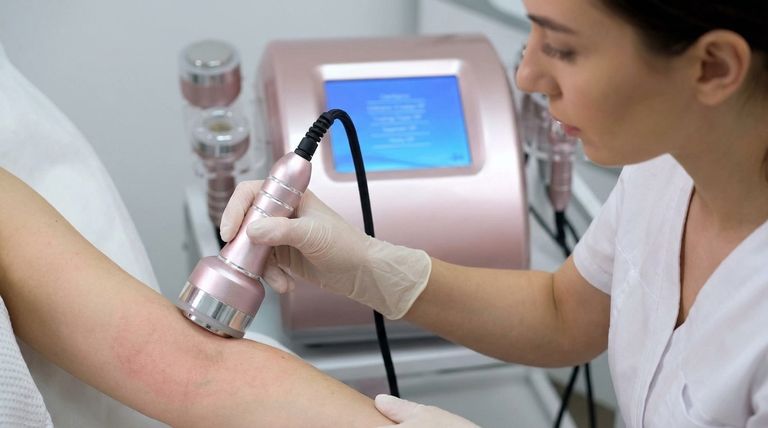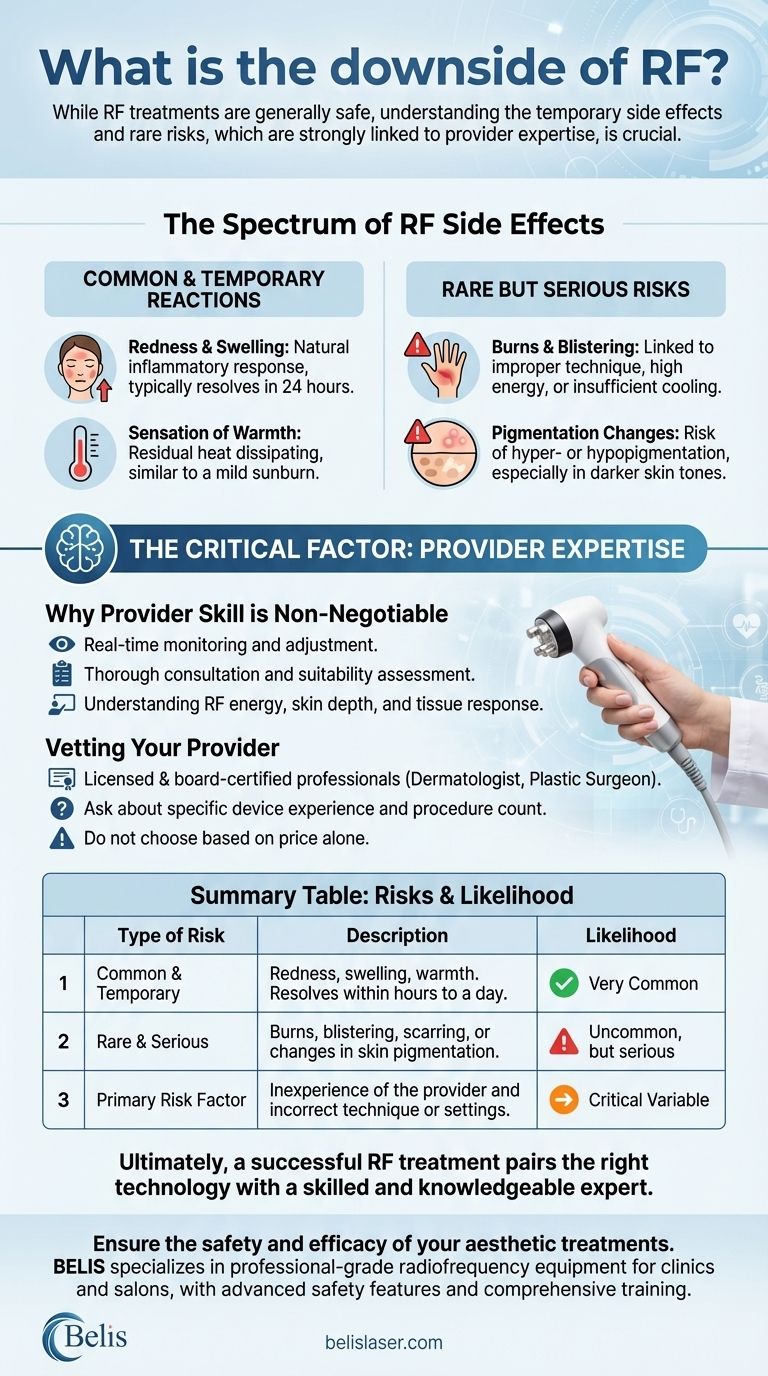The primary downsides of radiofrequency (RF) treatments are temporary side effects like mild redness and swelling. While generally considered safe, there is a rare but serious risk of burns if the procedure is not performed correctly by an experienced professional.
The safety and effectiveness of any radiofrequency treatment are not determined by the technology alone. The most significant variable, and therefore the most critical risk factor, is the skill and experience of the person operating the device.

The Spectrum of RF Side Effects
Radiofrequency treatments use energy to heat the deeper layers of your skin, stimulating collagen and elastin production. The side effects, both common and rare, are a direct result of this controlled thermal process.
Common and Temporary Reactions
Most patients experience only minor side effects that are a predictable part of the skin's healing response. These typically resolve on their own within hours.
- Redness and Swelling: Applying heat to the skin triggers a natural inflammatory response, causing temporary redness (erythema) and mild swelling (edema). This is expected and usually subsides within 24 hours.
- Sensation of Warmth: The treated area may feel warm, similar to a mild sunburn, for a few hours following the procedure. This is simply the residual heat dissipating from the tissue.
Rare but Serious Risks
While uncommon, more significant complications can occur. These risks are almost always linked to improper technique, incorrect energy settings, or inadequate assessment of the patient's skin type.
- Burns: This is the most severe potential downside. A burn can happen if the device's handpiece is held in one spot for too long, if the energy level is set too high for your skin, or if there is insufficient cooling or coupling gel used during the treatment.
- Blistering or Scabbing: In cases of excessive heat injury that doesn't result in a full burn, the skin may blister or form scabs as it heals. This increases the risk of scarring or changes in skin texture.
- Changes in Pigmentation: Any heat-based treatment carries a risk of post-inflammatory hyperpigmentation (dark spots) or, more rarely, hypopigmentation (light spots). This is a greater concern for individuals with darker skin tones, as their pigment-producing cells are more easily stimulated by heat.
The Critical Factor: Provider Expertise
The single most important way to mitigate the downsides of RF treatment is to choose the right provider. The technology is only as safe as the hands controlling it.
Why Provider Skill is Non-Negotiable
An experienced provider understands the complex interplay between RF energy, skin depth, and tissue response. They are trained to visually monitor the skin for signs of excessive heating and to adjust their technique in real-time.
A qualified professional will conduct a thorough consultation to ensure you are a suitable candidate. They will assess your skin type, medical history, and treatment goals to create a safe and effective plan.
Vetting Your Provider
Do not choose a provider based on price alone. Look for a licensed and board-certified dermatologist, plastic surgeon, or a highly-trained nurse or aesthetician working under their direct supervision. Ask pointed questions about their specific experience with the RF device being used and how many procedures they have performed.
Making the Right Choice for Your Goal
Understanding the risks allows you to make an informed decision and take steps to ensure a safe outcome.
- If your primary focus is minimizing risk: Your entire effort should be dedicated to vetting and selecting a highly experienced, credentialed provider.
- If your primary focus is achieving the best results: Ensure your provider sets realistic expectations during your consultation and confirms that your skin concerns are well-suited for RF treatment.
Ultimately, a successful radiofrequency treatment is the direct result of pairing the right technology with a skilled and knowledgeable expert.
Summary Table:
| Type of Risk | Description | Likelihood |
|---|---|---|
| Common & Temporary | Redness, swelling, warmth. Resolves within hours to a day. | Very Common |
| Rare & Serious | Burns, blistering, scarring, or changes in skin pigmentation. | Uncommon, but serious |
| Primary Risk Factor | Inexperience of the provider and incorrect technique or settings. | Critical Variable |
Ensure the safety and efficacy of your aesthetic treatments.
At BELIS, we specialize in providing medical aesthetic clinics and premium beauty salons with professional-grade radiofrequency equipment. Our devices are engineered with advanced safety features and are complemented by comprehensive training and support for your practitioners.
Invest in technology you can trust, backed by expertise that prioritizes patient safety and outstanding results.
Contact BELIS today to learn more about our professional RF solutions and how we can support your practice.
Visual Guide

Related Products
- Ultrasonic Cavitation Radiofrecuency Machine for Body Slimming
- EMSlim Body Sculpting Machine EMS Body Slimming Machine
- Cryolipolysis Fat Freezing Machine and Ultrasonic Cavitation Device
- Cryolipolysis Fat Freezing Machine Ultrasonic Cavitation Fat Reducing Device
- 4D 12D HIFU Machine Device for Skin Tightening
People Also Ask
- When should you not use a cavitation machine? Critical Safety Guidelines for Aesthetic Treatments
- What are the restrictions for cavitation? Ensure Your Safety and Treatment Success
- Does cavitation get rid of belly fat? Yes, Here's How It Works for Body Sculpting
- What are the negative side effects of cavitation? Understanding the Risks for Your Practice
- Do fat cavitation machines really work? A Professional's Guide to Body Sculpting



















